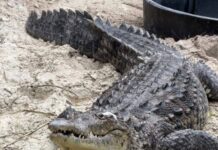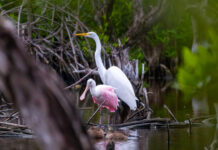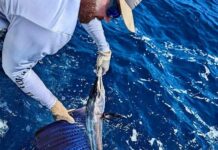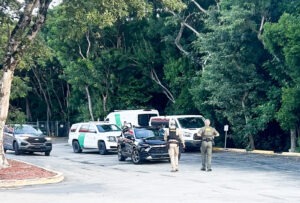
A Peregrine falcon is not an off-the-shelf bird. There are very few places in the world where you can decide you want to see a Peregrine falcon, and then go out and see one. They are just too mobile and elusive. The very word “peregrine” means one who wanders.
There are two main workarounds for this. During the nesting season, peregrines are behaviorally tied to the area of their nest. Both parents share in the raising of their chicks, and they have to make multiple sorties each day for food. So one way to game the system and lay eyes on them is to figure out where there’s a nest. Usually it’s on a rocky cliffside, though in recent years quite a few have shown up on towering buildings in urbanized areas, such as atop the 286-foot 4 ¼-inch tall library at UMass Amherst, or in the gray 548-foot-high tower of Philadelphia’s City Hall, not too far below Willie Penn’s boots. And then just wait for them to fly in and out.
Seeing them this way tends to leave you in a state of simultaneous wonder and loneliness, as most people won’t be as thrilled as you are, no matter how much you try to exhort them to. (In my experience, public exhortation in urbanized areas is generally taken as a sign of mental instability.)
The other way to be almost guaranteed to see a peregrine is to be in the Florida Keys during the next month and paying attention. I say this simultaneously too often and not often enough, but every fall the Florida Keys become the Peregrine falcon capital of the world – the world! – as more of them pass through here than any other spot on the planet.
There are multiple ways to approach seeing them here. The easiest is to make a trip to Curry Hammock State Park on Little Crawl Key, home of the Florida Keys Hawkwatch. There, even if you find one yourself, one of the hawkwatchers will no doubt let you know when they see one.
You can also make your way to one of the tall radio towers in the Keys. Peregrines like to perch on them – the highest things in the landscape – late in the day. So if you scan them up and down with a pair of binoculars, you’ve got a good chance of seeing them. Look for the things that break up the rhythms of the structures, the odd shapes that don’t look manmade. A perched peregrine looks something like a skinny football with a head and a flesh-tearing bill. I counted 19 of them in the same tower near Truman Waterfront once. Keep in mind these are birds that do not enjoy the company of other birds, outside of their mate and offspring for three months every year. They just don’t have many options to perch. (The rooftop of The Studios of Key West can be a good place to see them in flight, usually in the late morning. Check TSKW’s schedule to see when they’re open.)
I was up in the northeast for most of the last month. I visited five different hawkwatches between New Hampshire and Virginia while there, and I saw a lot of raptors – northern harriers, merlins, red-tailed hawks, red-shouldered hawks, American kestrels and others. But the species I hadn’t seen this fall somehow was, of course, the Peregrine falcon.
While the Florida Keys Hawkwatch has the best numbers, peregrines do get seen in smaller numbers in other places. Just not, apparently, by me this fall.
I suppose I could have taken my own Key West-based suggestions and gone to the roof of the Studios, or gone to the trusty tower at Truman Waterfront. But I was heading to Miami to see the avant garde, post-prog rock, post-punk, kind-of-hard-to-describe-it’s-better-to-just-listen-to-them band, Sigur Ros, play with a 40-plus piece orchestra, and I had a little time. So I decided to stop by the hawkwatch.
When I got there, the three hawk counters – Gianna Arcuri, Chris Payne and Adrianna Nelson – were all standing in a line, as if posing, bent with their eyes to their spotting scopes, staring at something in the distance.
I always think of that Bruce Springsteen line, “one step up and two steps back,” at the beginning of every hawk-watching season. Springsteen was singing about a disintegrating marriage, but I’m thinking more in terms of the attrition of skills, and the proper ratio for me is probably two steps up and one step back. But I just forget so much, and lose so much acuity, between seasons. Birds I could identify quickly, with an amazingly minuscule amount of information, 10 months before, require a good amount of thought, and sometimes still sometimes stump me.
I figured out where their scopes were pointing, and saw what they were looking at. It was apparently a broad-winged hawk, but it was just a speck to me, getting lighter and darker as it got closer and farther from the wispy cloud in the background. (The beginning of hawk season is also when I get reacquainted with my eye floaters every year.)
The flight line was way off, somewhere beyond the highway. In the next 20 minutes there were other birds, notably a northern harrier, an American kestrel, a merlin and finally a peregrine falcon. But I was taking their word for it. I wanted that click in my brain, that dopamine hit that comes with seeing a challenging bird and knowing what it is.
I was beating myself up a bit, but in my defense, Gianna, Chris and Adrianna all had young eyes and had been working together at Curry Hammock for close to two months, which was a pretty solid route to clarity and sharpness. They knew where, and apparently when, to look.
They have actually counted a record 5,100 swallow-tailed kites since the start of the season, though swallow-tails migrate earlier than most of the other raptors that come through the Keys, and their numbers are petering out. A few other peregrines were called out during a conversation about how they wanted 7 or 38 more swallow-tails, because if they saw exactly 5,100 swallow-tails in a season, it might look a little dubious.
Finally, as the discussion of what the most authentic looking number would be for their very authentic data, I caught sight of a bird relatively low on the horizon. It moved quick and straight, and I was worried it was going to be another question mark for me, but then, almost as if it were throwing its ID to me underhanded, it banked, and there were the telltale pointed wingtips, and that damp flash went off in my hypothalamus. Peregrine!
My brain was back. Or on the road to being back. Probably. Why define it? It just felt good. I got so giddy that they let me push the button on the clicker to record it.
It was their 12th peregrine that hour, on what would turn out to be a 147-peregrine day.
They’d count 160 the next, and probably more the day after that.





















